

RecycledAggregates.pdf. Counterform Distribution. 421-0899. 6505-5. Tensile Test on Concrete. Back to Main Page Tensile strength is an important property of concrete because concrete structures are highly vulnerable to tensile cracking due to various kinds of effects and applied loading itself.
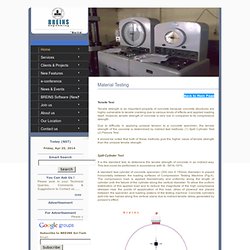
However, tensile strength of concrete is very low in compared to its compressive strength. Due to difficulty in applying uniaxial tension to a concrete specimen, the tensile strength of the concrete is determined by indirect test methods: (1) Split Cylinder Test (2) Flexure Test. It should be noted that both of these methods give the higher value of tensile strength than the uniaxial tensile strength. Split-Cylinder Test It is the standard test, to determine the tensile strength of concrete in an indirect way. Recycled / secondary aggregate literature. Killingsworth-Recycled%20Materials%20in%20Concrete. Recovering and using recycled aggregates. AggRegain. RecycledAggregates.
Aggregates. Aggregates are inert granular materials such as sand, gravel or crushed stone that are an end product in their own right.
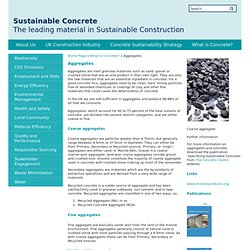
They are also the raw materials that are an essential ingredient in concrete. For a good concrete mix, aggregates need to be clean, hard, strong particles free of absorbed chemicals or coatings of clay and other fine materials that could cause the deterioration of concrete. In the UK we are self-sufficient in aggregates and produce 99.98% of all that we consume. Aggregates, which account for 60 to 75 percent of the total volume of concrete, are divided into several distinct categories, and are either coarse or fine: Coarse aggregates Coarse aggregates are particles greater than 4.75mm, but generally range between 9.5mm to 37.5mm in diameter. Data Sources - Data for Recycled and Secondary Aggregates. Survey of Arisings and Use of Alternatives to Primary Aggregates in England, 2005: Construction, Demolition and Excavation Waste - Final Report The construction, demolition and excavation waste surveys, based at two yearly intervals between 1999 and 2005, have provided information on the arisings and use as an alternative to primary aggregates of construction, demolition and excavation waste (CDEW).
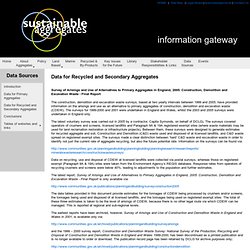
The surveys for 1999-2000 and 2001 were undertaken in England and Wales, whilst the 2003 and 2005 surveys were undertaken in England only. The latest voluntary survey was carried out in 2005 by a contractor, Capita Symonds, on behalf of DCLG). Good Economic Sense. Use Of Recycled Aggregate In Concrete. Use of recycled aggregate in concrete can be useful for environmental protection.
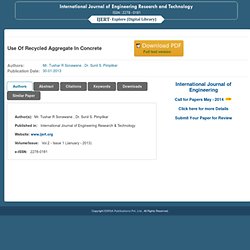
Recycled aggregates are the materials for the future. 4001.0%20Guide%20Specification%20SLWC. Tip9. ASTM C330: Standard Specification for Lightweight Aggregates for Structural Concrete : American Society for Testing and Materials. Fullscreen Author:American Society for Testing and MaterialsSubject:federalregister.gov;public.resource.orgYear:1999Language:EnglishCollection:publicsafetycode; USGovernmentDocuments; additional_collections Description.
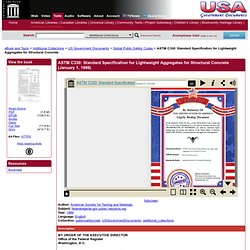
Full text of "Sawdust-cement concrete" Building a Sawdust Concrete Home - Green Homes. Related Content Greening the Green Girl Environmental journalist Simran Sethi talks about buying her first home and discusses what eco-frien...

Blood. Latex. Extraction of latex from a tree, for use in rubber production Latex is the stable dispersion (emulsion) of polymer microparticles in an aqueous medium.
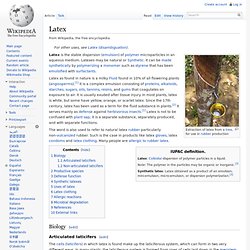
Latexes may be natural or Synthetic. It can be made synthetically by polymerizing a monomer such as styrene that has been emulsified with surfactants. Latex as found in nature is a milky Fluid found in 10% of all flowering plants (angiosperms).[1] It is a complex emulsion consisting of proteins, alkaloids, starches, sugars, oils, tannins, resins, and gums that coagulates on exposure to air. It is usually exuded after tissue injury. The word is also used to refer to natural latex rubber particularly non-vulcanized rubber. IUPAC definition. Austin Resource Recovery. Free, High Quality Paint Residents looking to save money when refurbishing their homes now have a free resource - Austin Resource Recovery's Austin ReBlend paint!
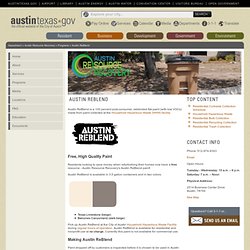
Recycling waste latex paint in concrete. Abstract Currently, in Ontario, Canada, around 21.7% of the total hazardous waste (HZW) collected by municipalities is waste paint.
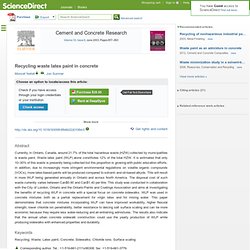
Waste latex paint (WLP) alone constitutes 12% of the total HZW. It is estimated that only 10–30% of this waste is presently being collected but this proportion is growing with public education efforts. In addition, due to increasingly more stringent environmental regulations on volatile organic compounds (VOCs), more latex-based paints will be produced compared to solvent- and oil-based alkyds. This will result in more WLP being generated annually in Ontario and across North America. Keywords. PaintcreteGrantFinalReport_1996. Latex (Reduces Water Requirements and Increases Strength) Recycling waste latex paint in concrete. Quarry Dust, Rice Husk, and Kenaf Power as San Alternative. Rice Husk Supplier. - Rice husk has a number of names, the most common being husk, hull, and chaff - ricehusk.com Pte Ltd supplies rice husk in raw, ground, powder, and briquette forms.
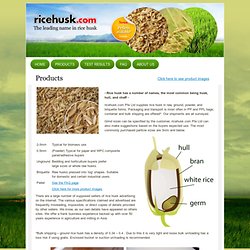
Rice concrete can cut greenhouse emissions - Technology & science - Science - DiscoveryNews.com. A new way of processing rice husks for use in concrete could lead to a boom in green construction. Rice husks form small cases around edible kernels of rice and are rich in silicon dioxide, an essential ingredient in concrete. Scientists have recognized the potential value of rice husks as a building material for decades, but past attempts to burn it produced an ash too contaminated with carbon to be useful as a cement substitute. The world's penchant for consuming concrete is a huge problem for climate change. Every ton of cement manufactured for use in concrete emits a ton of the greenhouse gas carbon dioxide (CO2) into the atmosphere. Worldwide, cement production accounts for about 5 percent of all CO2 emissions related to human activity.
Now, Rajan Vempati of ChK Group, Inc. in Plano, Texas, and a team of researchers have figured out a way to make nearly carbon-free rice husk ash. "The process emits some CO2, but it's carbon neutral. . © 2012 Discovery Channel. Recycled Crushed Porcelain Aggregate. Ceramics. Effects on concrete durability of using recycled ceramic aggregates. Future Cement - The Concrete Producer. Novacem cement, made with magnesium oxide, was on MIT Technology Review's list of the 10 most important emerging technologies in 2010, and also a Bloomberg New Energy Pioneer.
Ceratech pozzolanic cement with high amounts of fly ash is used to produce concrete that resists acid and chemical corrosion—ideal for industrial applications. Editor's note: This two-part article explores the latest technologies in developing low- and carbon-negative cements. Part One was published in the August-September 2012 issue. THE NEED TO reduce CO2 emissions has led to the development of many new cementitious materials—a trend that will likely continue for the foreseeable future.
But the powerful international portland cement business hasn't given up yet. Lafarge Canada is producing low-carbon Contempra cement with up to 15 percent limestone content, with plans to introduce it in the U.S. RiceHusks. A preliminary study of manufacture of cement from rice husk ash. Abstract Cement has been successfully produced from the agricultural waste, rice husk ash. Alternatives to Portland Cement. Calcined Clay. Production and Use of Calcined Natural Pozzolans in Concrete.
Volume 23, Issue 2 (December 2001) Production and Use of Calcined Natural Pozzolans in Concrete Abstract The goal of producing concrete that provides longterm durability with regard to properties such as improved sulfate resistance and reduced susceptibility to alkali-silica reactions (ASR) has led to the development of several high-performance materials. While the use of fly ashes and ground granulated blast-furnace slags (GGBFS) in concrete is gaining acceptance in various applications, the mineralogical composition of such byproduct materials cannot be as easily controlled as a manufactured pozzolan.
Since 1993, Ash Grove has developed and directed the manufacture of pozzolans to improve concrete durability, while avoiding the potential problems of byproduct pozzolan availability and uniformity. Raw materials for pozzolan manufacture are chosen using criteria such as alkali content, silica-to-alumina ratio, and the presence of minor constituents. Author Information: Stock #: CCA10478J. The Construction Civil. Dahana. Taming the Toughness of Limestone, Semen Merah Putih’s Raw Material The work performance of PT DAHANA (Persero)’s Quarry and Construction Division keeps getting tested.
The division also increasingly keeps establishing its role in becoming a major player in the quarry and construction sectors. With a domestic market of more than 90 percent, the division is currently working on a number of new site projects, both of quarry and construction spreading all across the islands of Indonesia. The division is divided into two business sectors, the first being quarry which includes granite, andesite and cement quarries while the latter is construction.
The main focus of the quarry sector is maintaining existing customers while expanding the market and also enhancing the service quality from spot sales to full services. One of the latest projects is located in the village of Pamubulan, Bayah, Lebak, Banten. Dahana conducted a thorough preparation for the Semen Merah Putih project. Lightweight Concrete. Engineeringproperties. Structural Engineering Magazine, Tradeshow: Is Lightweight Concrete All Wet? Concrete Table on Pinterest. Concrete furniture on a diet: Cool looks, lighter weight. Pantone declared a kicky orange called Tangerine Tango as color of the year, but one of the most interesting shades hitting stores and websites this season is the cool, calm, collected gray of concrete. The material’s sheer weight made it too difficult for furniture makers to manipulate and too expensive for retailers to ship in years past, but lately designers have been experimenting with lightweight composites that allow a shopper to carry a concrete side table without getting a hernia.
Zachary A. Bitner said one of his chairs in traditional concrete would tip the scale at 350 pounds, but when the same chair is made with his formulation of coarse sand and fiberglass, the weight drops to 50. The lighter composite needs no sealant and makes the piece easier to move and more resistant to cracking than concrete, Bitner said. His Spindle table, right, has a shapely silhouette that would be difficult to deliver in traditional concrete. Keep reading for about 10 more designs ...